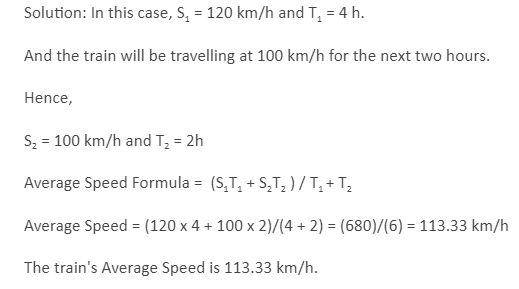Speed and velocity are two different entities. Average speed is defined as the total path length traversed by a body divided by the total time taken for the motion to take place. Instantaneous speed is the speed recorded at a specific point of time/at a particular instant. On the other hand, Average velocity implies the change in position of a body (displacement) divided by the time period in which the displacement has taken place. So, we can define instantaneous velocity as how fast a body moves when it is in motion at a particular instance during that specific time interval which is taken into account.
Average speed
The Average Speed is defined as the entire distance an object goes divided by the amount of elapsed time since it started moving. Since it is defined solely by a magnitude, the average speed is unquestionably a scalar quantity.
Average Speed Formula
The following is the formula for average speed:

This formula is similar to the formula for constant speed. The Average Speed is measured in the distance travelled per unit of time. Miles per hour (mph), kilometres per hour (km/h), metres per second (m/s) and feet per second (ft/s) are some of the most often used units of speed.
Let’s say the Average Speed of your brand-new red sports automobile, according to your friend’s assessment, was perfect! He divided the distance travelled by car (45 miles) by the elapsed time (1.25 hours). The work on the highway, as well as a slew of red lights on the side roads, significantly hampered your progress. As a result of the long elapsed time, the average speed was low. Mistakes and assumptions that are often made while calculating the same are defined in the next section.
Misconceptions about Average Speed
The Average Speed doesn’t need to have the same magnitude as the average velocity. Average Speed and average velocity are two distinct names for the same quantity. However, average speed relies on distance, and average velocity depends on displacement. Average Speed and average velocity are not the same things.
Suppose a body changes direction throughout its travel. In that case, the distance will be larger than the displacement, and the average speed will be more than the magnitude of the average velocity.
Average speed is a scalar quantity, but average velocity is a vector quantity. When the displacement is in the negative direction, the average velocity reflects the direction of the displacement and can be expressed as a negative number. In contrast to average velocity, which indicates direction, the Average Speed can only be positive or zero.
Numericals on Average Speed
Q1: A car moves at a speed of 30 km/hr for 2 hours and then slows down to 20 km/hr for the next 1 hour. Find the Average Speed of the car.
Solution: Distance 1 = 30 x 2 = 60 km
Distance 2 = 20 x 1 =20 km
Distance total = Distance 1 + Distance 2
D = 60 + 20 = 80 km
Total distance travelled / Total time taken = Average Speed = 80/3 = 26.67 km/hr
Q2. Using the Average Speed method, calculate Ria’s Average Speed for the first 10 km in four hours and the next 16 km in another six hours.
Solution: The whole distance and total time are required to calculate the Average Speed.
Ria’s total distance travelled = 10 km + 16 km = 26 km
Ria’s total time is 4 hours + 6 hours = 10 hours.
Average Speed = Total Distance Travelled/Total Time Spent
Average Speed = 26/10 = 2.6 km/h
Ria’s Average Speed is 2.6 kilometres per hour.
Q3. A train moves at a speed of 120 km/h for the first four hours and then at a speed of 100 km/h for the remaining two hours. Using the Average Speed formula, determine the train’s Average Speed.

Conclusion
The Average Speed doesn’t need to have the same magnitude as the instantaneous velocity. Average Speed and instantaneous velocity are two distinct names for the same quantity. However, average speed relies on distance, and instantaneous velocity depends on displacement. Average Speed and instantaneous velocity are not the same things. Instantaneous velocity is a vector quantity used to find out the velocity of a body in motion at a particular point of time when a certain time interval is taken into account. It is an important modality which can be used by physicists, mathematicians, and statisticians to solve problems related to our day-to-day lives and understand the physics behind it.
 Profile
Profile Settings
Settings Refer your friends
Refer your friends Sign out
Sign out




